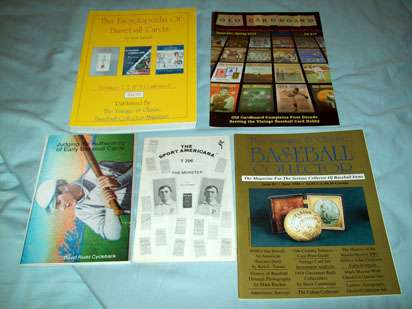III. Educational sources

Once you've assembled your starter kit, and your supplies, it's time to start learning about the cards you want to buy. You can, of course, do all these at the same time, but it's important to have the items you need before the cards start coming in.
There are a plethora of books, magazines and online articles to assist you in learning about the hobby, no matter what your focus will be. You might decide to collect cards from one era only, or, you might be like me, and collect from all three. "Pre-war cards" consist of cards produced starting in the Nineteenth Century all the way up until the beginning of World War II. "Vintage cards" are those produced starting after the beginning of World War II up until the year 1980. And modern cards encompass those produced from 1981 on. 1981 was a landmark year for the hobby, as Topps saw their virtual monopoly on baseball cards vanish with the reintroduction of Fleer cards, and the addition of the Donruss company. Then, in 1989, Upper Deck joined the hobby. These are general guidelines that will help you decide what publications you want to collect.
I've included several different books and magazines I've purchased in learning about the hobby. I was perhaps a tad cautious before beginning. I literally spent five or six months reading, and asking questions, before I started buying cards. In the upper left corner is
The Encyclopedia of Baseball Cards by Lew Lipset. This was a combined issuance of 3 volumes he'd previously released. You can still find this occasionally on EBay. I think I spent $30 on mine. It's a veritable treasure trove of information for pre-war baseball cards. It covers, in great detail, cards produced before 1900, as well as tobacco and candy cards produced before the start of World War II. Lew covers all the sets released, as cataloged by Jefferson Burdick in his
American Card Catalog. Mr. Burdick was the first person to sit down, and create an organizational system identifying all the different pre-WWII sets. Cards with an "N" prefix covered cards issued prior to 1900. "T" cards included the sets of cards which could be found in packs of tobacco. "F" cards were found in packages of food and ice cream. "D" cards were found with baked goods, including bread. "E" cards were found with caramels, "R" cards with gum, etc. The book includes background information, as well as checklists. It's an essential item for collectors of old cards, and infinitely fascinating.
The little white booklet in the picture is
The Sport Americana T206 The Monster, by Bill Heitman. Bill Heitman was the first to call the T206 set "the Monster". It's nearly four decades old by now, but it's an essential read for those who collect the set. It breaks down the set by print run, and by back. The checklist has been expanded since 1980, but it's still one of the best resources for understanding how the set is constructed. It can still be found on EBay, occasionally, for $15-20.
I've also included the book
Judging the Authenticity of Early Baseball Cards by David Cycleback. David is a member of Net 54, and a widely respected expert/scholar in art, artifact and photograph authentication. While the book relates specifically to pre-WWII baseball card production, the lessons learned are invaluable to collectors of all eras. He goes into the use of black light in spotting alterations, as well as comparing the printing techniques (ink), card stock and paper of different samples under high-power magnification (microscopy utilizing 50X to 100X power). More than even these specifics he provides, his book gets the collector thinking in the proper frame of mind. He teaches the hobbyist to be a discriminating buyer, introducing the importance of discerning between authentic, reprint, and fakes. I've included a link to his booklet on sale at Amazon.
Lastly, I've included examples of two different magazines, the first being
The Vintage and Classic Baseball Collector (which is no longer being produced), and
Old Cardboard Magazine, which is still in production, with new issues coming out once a year. The VCBC back issues are commonly sold on EBay. Old Cardboard can be purchased on their site. I have linked directly to their order page. I have a collection of about 20 issues between the two titles, and they are both outstanding. They're fun reads, and they're highly insightful.
In addition to these printed books and periodicals, there are a lot of great websites devoted to the collection, including
Sports Collectors Digest. They also have their own publication. Many other vintage and pre-war sites can be found in the
vintage links page on our site. Lastly, there may be no better resource for collectors than Net 54. Learn to use the search function on our forum. If you've got a question, then chances are it's already been asked here before. I use our search function and Google together, and have never had an issue finding what I'm needing. It's good etiquette to look first, and then ask if you're unable to find what you're looking for.